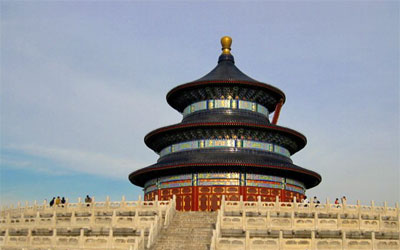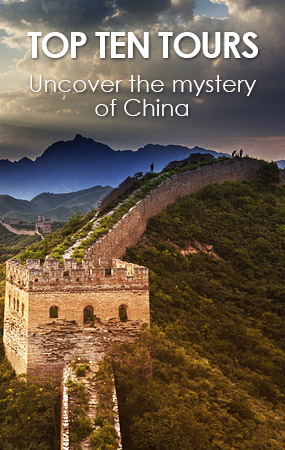The Temple of Heaven
The Temple of Heaven is the most holy of Beijing's Imperial temples. For this is where the Emperor came every winter solstice to worship heaven and to solemnly pray for a good harvest.
Temple of Heaven Facts
- Names: Temple of Heaven (Chinese Pinyin: Tīan Tán 天坛)
- History: Built in AD 1420, Ming Dynasty
- Status: Holy place for the Emperors of the Ming and Qing dynasties for annual ceremonies of prayer to Heaven for good harvest
- Location: 1 Tiantan Road, Chongwen District, Beijing
-
Opening Hours:
6:00am - 5:30pm (Mar.1 to June.30)
6:00am - 6:00pm (July.1 to Oct.31)
6:00am - 5:00pm (Nov.1 to Feb.28)
-
Admission Fee:
The park only: RMB15(Peak season, Apr.1 to Oct. 31); RMB10(Low season, Nov. 1 to Mar. 31)
Combo ticket (including the entrance fee of three places, the Circular Mound Altar, the Hall of Prayer for Good Harvests and the Imperial Vault of Heaven): RMB35(Peak season, Apr.1 to Oct. 31); RMB30(Low season, Nov. 1 to Mar. 31)
-
How to get to Temple of Heaven:
Bus No.3, 6, 17, 20, 35, 39, 54, 106, 116, 120, 122, 803;
Subway line 5 and take off at Tiantan East Gate Station.
- Tel: 010-67012402/010-67028866
Architecture and Layout
 The architecture and layout of the temple of Heaven is based on elaborate symbolism and numerology. In accordance with principles dating back to pre-Confucian times, the buildings in the Temple of Heaven are round, like the sky, while the foundations and axes of the complex are rectilinear, like the earth. Three principle structures lie along the primary north-south axis of the Temple of Heaven: The Circular Mound Altar, The Imperial Vault of Heaven and Hall of Prayer for Good Harvests.
The architecture and layout of the temple of Heaven is based on elaborate symbolism and numerology. In accordance with principles dating back to pre-Confucian times, the buildings in the Temple of Heaven are round, like the sky, while the foundations and axes of the complex are rectilinear, like the earth. Three principle structures lie along the primary north-south axis of the Temple of Heaven: The Circular Mound Altar, The Imperial Vault of Heaven and Hall of Prayer for Good Harvests.
Ceremony
Temple of Heaven is where the Emperor came every winter solstice to worship heaven and to solemnly pray for a good harvest. Since his rule was legitimised by a mandate from heaven, a bad harvest could be interpreted as his fall from heaven's favour and threaten the stability of his reign. So, it was not without a measure of self-interest that the Emperor fervently prayed for a very good crop.
In line with the Confucianist revival during the Ming dynasty, the sacred harvest ceremony was combined with the Emperor's worship of his ancestors. This embellishment was also, in effect, self-interested. For according to the Confucian pattern of social organisation, just as the Emperor respected his ancestors, so a younger brother should respect an elder brother, a wife her husband, a son his father, and a nation's subjects their ruler. Incorporating ancestor worship within the most solemn ceremony of the Imperial ritual calendar, indirectly reinforced the social philosophy that perpetuated the Emperor's power.
Symbolism
The design of the Temple of Heaven complex, true to its sacred purpose, reflects the mystical cosmological laws believed to be central to the workings of the universe. Hence, complex numerological permutations operate within its design.
For example, because the number nine was considered to be the most powerful digit, you will see that the slabs that form the Circular Altar have been lain in multiples of nine. Similarly within the Hall of Prayer for Good Harvest, the interior twenty-eight columns are divided into four central pillars to represent the seasons, twelve inner columns to represent the months and twelve outer columns to represent the two hour tranches that make up a day. There are many such examples of this intense numerology at play.
Temple of Heaven Today
Whereas in Imperial times commoners were not allowed to enter the enormous park, now for a minimal fee Chinese citizens can enjoy it all day long.
Were you to visit at dawn you'd be surprised by the number of people there performing their morning exercises. Next to an older person practising the slow and flowing movements of Tai Qi there might be a younger one performing vigorous karate-like punches and kicks. One group might be learning the ancient martial art of sword-fighting, while another might be practising a traditional dance.
Should you have the energy and the inclination, it is well worth waking up early one morning and visiting this park to watch such events take place. We offer morning tours to the Temple of Heaven to catch a glimpse of the morning life of the Beijingers.
Recommended Tours including the visit to the Temple of Heaven
- Beijing Temple of Heaven Tour: from US$55 only
- Essence of Beijing Tour: 4 days to Mutianyu Great Wall, Temple of Heaven, the Forbidden City...
- Early Morning Tour of Temple of Heaven: from US$29 only
- Flag Raising Ceremony & Temple of Heaven Morning Tour: from US$29 only


